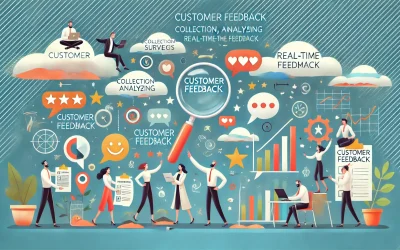Blog 4: Enhancing Customer Experience with LogRocket – A Deep Dive into Improving User Journeys
In today’s product landscape, understanding how customers interact with digital products is critical. Traditional customer feedback channels like surveys and interviews provide valuable insights, but they often lack the context of real-time interaction with the product. This is where LogRocket comes in—a robust, user-focused analytics tool that allows product and development teams to get a firsthand view of customer interactions, experiences, and potential pain points. By capturing user sessions, logging errors, and tracking key engagement metrics, LogRocket provides a powerful way to enhance the customer experience.
In this post, we’ll explore how LogRocket works, its core features and benefits, specific use cases, and best practices for integrating it with your product development process. Additionally, we’ll examine how LogRocket, when paired with traditional feedback methods, creates a more comprehensive understanding of customer needs.
Why Customer Experience Analytics Matter
Before we dive into LogRocket specifically, it’s essential to understand why customer experience analytics is so crucial. In a world where customer expectations are higher than ever, even small usability issues or friction points can lead to dissatisfaction, higher churn rates, or negative reviews. According to a study by PwC, “32% of customers will stop doing business with a brand they love after just one bad experience.” In contrast, a smooth, well-optimized user journey can significantly improve customer retention, satisfaction, and advocacy.
Analytics tools like LogRocket help you go beyond traditional feedback by observing user behavior in real-time. By understanding precisely where users struggle or succeed, teams can make data-informed decisions to optimize their products.
What is LogRocket?
LogRocket is a digital experience analytics tool that records user sessions within web applications, enabling product and development teams to see how customers interact with the product in real time. It provides a visual, intuitive understanding of the customer journey, tracking everything from clicks, form fills, and navigation to user-encountered errors and performance bottlenecks.
Key Features of LogRocket include:
- Session Replay: LogRocket captures actual user sessions, allowing teams to replay them and observe how users navigate the application.
- Performance Monitoring: Tracks page load times, performance bottlenecks, and other technical aspects impacting user experience.
- Error Tracking: Logs JavaScript errors, console logs, and network activity so teams can diagnose issues.
- User Insights and Analytics: Provides analytics on user behavior patterns, drop-off points, and feature engagement.
These features give product teams comprehensive visibility into the customer experience, allowing them to address issues more effectively and improve user satisfaction.
Core Benefits of Using LogRocket
- Identify Pain Points in Real-TimeOne of LogRocket’s standout features is session replay, which provides a video-like view of user sessions. With session replay, you’re no longer guessing why users drop off or abandon their sessions. Instead, you can see firsthand where customers encounter problems, be it navigation difficulties, form errors, or confusing content.
Imagine a scenario where users are frequently abandoning the checkout process. Instead of speculating about potential reasons, LogRocket allows you to observe these sessions, pinpoint the exact screen or form where users are dropping off, and identify any specific technical errors contributing to the issue. This actionable insight enables you to address real problems, improving the customer journey and reducing abandonment rates.
- Enhanced Error Tracking and DebuggingBugs are inevitable in any application, but how quickly they are detected and resolved can significantly impact the user experience. LogRocket provides detailed error-tracking capabilities, logging JavaScript errors, network requests, and console logs within the context of user sessions. This contextual data can drastically reduce debugging time by providing developers with all the information needed to reproduce and fix issues.
For example, suppose users encounter a “Submit” button that doesn’t respond as expected. LogRocket’s error-tracking capabilities help developers identify the specific error type, understand its frequency, and assess how many users it impacts. Rather than sifting through server logs or relying on fragmented user feedback, developers have all the data at their fingertips, expediting troubleshooting and minimizing disruptions for users.
- Detailed User Insights for Better Product DecisionsIn addition to its error and session-tracking features, LogRocket provides robust analytics that helps product teams understand how users engage with specific features. By examining metrics like click-through rates, feature usage, and session durations, teams can assess whether users are interacting with the product as intended.
LogRocket allows teams to monitor conversion funnels, showing where users may drop off during key stages. For example, a team working on an e-commerce site could use LogRocket’s analytics to evaluate the checkout process. If users are abandoning their carts at a specific step, LogRocket can reveal whether it’s due to a long load time, a form issue, or simply confusing instructions.
- Improved Collaboration Across TeamsLogRocket’s comprehensive reporting capabilities make it easy to share findings across teams. By sharing session replays and error logs with product managers, designers, and developers, all team members gain a unified understanding of the issues and their contexts. This shared insight fosters more effective collaboration, as everyone can see the problem from the user’s perspective, facilitating a collective approach to improving the product.
Use Cases for LogRocket
- Optimizing Onboarding ExperiencesThe onboarding experience is crucial for engaging new users and ensuring they see value in your product quickly. If users struggle with onboarding, they may abandon the product early on. LogRocket can be instrumental in optimizing this process by allowing product teams to observe the exact steps new users take and identify where they experience friction. By resolving these onboarding pain points, companies can increase user retention and improve initial user impressions.
- Reducing Cart Abandonment in E-CommerceFor e-commerce companies, cart abandonment is a persistent issue. LogRocket helps identify the specific steps where users are abandoning their carts. Teams can then address technical or usability issues, such as long load times or complex forms, which may be hindering conversions. Using LogRocket, one e-commerce company reduced its cart abandonment rate by 25% simply by improving checkout speed and simplifying form fields.
- Improving Form Usability and Submission RatesForms are a common feature in many applications, whether for registrations, feedback, or data entry. However, poorly designed forms can lead to frustration and high abandonment rates. LogRocket’s session replays allow teams to observe user behavior within forms, such as which fields they leave blank, where they encounter errors, or if certain fields cause confusion. This insight can be invaluable for optimizing forms to increase completion rates and reduce user frustration.
Integrating LogRocket into the Product Development Process
For maximum effectiveness, LogRocket should be integrated into each stage of the product lifecycle. Here’s how:
- Development and Testing
During development, LogRocket’s error-tracking capabilities help developers identify and resolve issues before launch. By observing how beta users interact with the product, teams can catch bugs, confusing interfaces, and other issues that may go unnoticed. - Product Launch
When launching a new product or feature, LogRocket’s real-time feedback enables teams to monitor user interactions closely. Any unexpected issues or usability challenges can be addressed quickly, minimizing negative user experiences. - Continuous Improvement
Post-launch, LogRocket supports ongoing optimization by providing insights into user behavior over time. Product teams can track which features are used most, identify friction points, and iteratively improve the product based on these insights.
Best Practices for Using LogRocket Effectively
- Set Clear Goals: Before diving into LogRocket, define specific goals for what you want to improve, whether it’s reducing cart abandonment, improving onboarding, or enhancing form usability. This helps focus your analysis.
- Prioritize Feedback: LogRocket captures a vast amount of data, so prioritize feedback that aligns with high-impact areas. For example, focus on bugs that affect critical user flows or high-traffic areas of the application.
- Combine with Traditional Feedback: While LogRocket provides invaluable user insights, combining its data with traditional customer feedback (like surveys or interviews) can yield a more comprehensive understanding of user needs and preferences.
- Share Findings Across Teams: Use LogRocket’s session replays and reports to promote transparency and collaboration between product, design, and development teams. Sharing insights helps ensure everyone is aligned on user needs.
Conclusion: Elevate the Customer Experience with LogRocket
LogRocket offers a powerful suite of tools that give product teams visibility into the real-time customer experience. By leveraging session replays, performance monitoring, and error tracking, teams can address issues proactively, prioritize impactful updates, and optimize the user journey. When used effectively, LogRocket enables a more data-driven approach to product development, fostering user satisfaction and retention.
By pairing LogRocket with traditional customer feedback methods, companies can build a truly customer-centric product development lifecycle. The insights gained from direct user interactions not only improve the product but also deepen the company’s understanding of its customers, paving the way for more strategic, impactful product decisions.
Incorporating LogRocket into your process means you’re not just reacting to user needs—you’re anticipating them, creating an experience that resonates, retains, and rewards users. Embrace the potential of LogRocket, and make your customer journey a seamless, rewarding experience.








